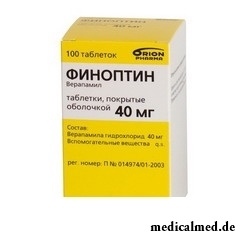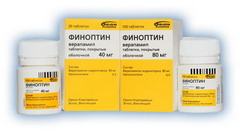





Finoptinum
Application instruction:
Pharmacological action
Active agent – verapamil a hydrochloride. Drug is derivative a difenilalkilamina, belongs to the selection locks  of calcium channels of the I class. Has anti-hypertensive, antiarrhytmic and anti-anginal effect.
of calcium channels of the I class. Has anti-hypertensive, antiarrhytmic and anti-anginal effect.
The anti-anginal effect is caused as well as direct impact on a myocardium, and action on peripheral geodynamics. Blocking intake of calcium in a cell, Finoptinum puts to decrease in transformation of the energy concluded in it in mechanical action, thus, reducing contractility of a myocardium.
Finoptinum considerably reduces atrioventricular conductivity and increases the refrakternost period. At supraventricular arrhythmias has antiarrhytmic effect.
Pharmacokinetics
At oral administration Finoptinum, getting in an organism, it is absorbed for 90%. Metabolism happens in a liver at "the first passing". The main metabolite – norverapamit. The elimination half-life, at one-time reception, makes – 2,5-7,5 hours, at further receptions of 4,5-12 hours. Drug is removed generally by kidneys and from 9 to 16% through intestines. After intravenous administration the elimination half-life is equal to 2-5 hours.
Indications to use of Finoptinum
- stenocardia (stable without vasomotor spasm, vasospastic);
- sinus tachycardia;
- supraventricular tachycardia;
- hypertensive crisis;
- ciliary tachyarrhythmia;
- primary hypertensia;
- atrial premature ventricular contraction;
- atrial flutter;
- arterial hypertension;
- hypertrophic subaortic stenosis.
Dosage of Finoptinum and instruction for reception
Internal reception – an initial dose 40-80 mg, 3 times a day. For the prolonged Finoptinum forms the single dose has to be increased, and the frequency of reception is reduced.
Perhaps intravenous administration of Finoptinum (struyno) – slowly, controlling the arterial pressure and the patient's pulse. To patients with the expressed liver dysfunction the daily dose of Finoptinum should not exceed 120 mg. The most admissible dose for adult patients at intake – 480 mg a day.
Side effects of Finoptinum
From cardiovascular system: obviously expressed lowering of arterial pressure, tachycardia, bradycardia, aggravation of heart failure; seldom - a myocardial infarction, stenocardia, arrhythmia; at bystry intravenous administration – a collapse, an atrioventricular block of the III degree, an asystolia.
From the central nervous system and peripheral nervous system: a depression, increased fatigue, dizziness, an adynamy, uneasiness, a syncope, block, drowsiness, a headache, extrapyramidal disturbances (trembling of hands, a mask-like face, the ataxy shuffling gait, swallowing difficulty, rigidity of extremities).
From the alimentary system: increase in appetite, a lock (it is rare - diarrhea), nausea, a hyperplasia of gums.
Other possible side effects of Finoptinum: increase in body weight, is extremely rare - a gynecomastia, an agranulocytosis, a galactorrhoea, a giperprolaktinemiya, arthritis, a fluid lungs, peripheral hypostases, thrombocytopenia asymptomatic.
Contraindications to use
- pregnancy;
- sinuatrial blockade;
- lactation period;
- atrioventricular block of II and III degrees;
- heavy arterial hypotension;
- hypersensitivity to Finoptinum.
Reception of Finoptinum at pregnancy and a lactation
In the period of a lactation and  at pregnancy Finoptinum is contraindicated to use.
at pregnancy Finoptinum is contraindicated to use.
Special instructions
According to the instruction Finoptinum should be applied with care:
- at a myocardial infarction with a left ventricular failure;
- at heart failure in a chronic form;
- at bradycardia;
- at Avblokade - the I degree;
- at a liver failure;
- at a heavy stenosis of the mouth of an aorta;
- at a renal failure;
- at slight or moderate arterial hypotension;
- to patients of advanced age;
- to children and teenagers 18 years are younger.
Influence on ability to work of the demanding concentration
After reception of Finoptinum manifestations of drowsiness and dizziness are possible that can negatively affect concentration of attention.
Medicinal interaction of Finoptinum
Combination Finoptinas anti-hypertensive drugs such kak:vazodilatator, APF inhibitors, thiazide diuretics, leads to mutual strengthening of anti-hypertensive effect.
Simultaneous use with beta adrenoblockers, means for an inhalation anesthesia, antiarrhytmic drugs, increases risk of development of bradycardia, heart failure, arterial hypotension. At parenteral administration of Finoptinum to the patients receiving beta adrenoblockers there is a risk of development of an asystolia and arterial hypotension.
At a combination Finoptinas cases of increase in a bleeding time are known for acetylsalicylic acid. The concomitant use with digoxin leads to increase in concentration of digoxin in a blood plasma.
The combination to Disopyramidum can cause heavy arterial hypotension and a collapse. Simultaneous use with diclofenac reduces concentration of verapamil in a blood plasma.
At reception, patients with arterial hypertension, Finoptinum with a clonidine, recorded cardiac standstill cases.
The concomitant use with phenobarbital or Phenytoinum can cause decrease in concentration of verapamil in blood.
Finoptinum combination with enflurany or etomidaty can cause increase in time of effect of anesthesia.
The stomach of the person not bad copes with foreign objects and without medical intervention. It is known that the gastric juice is capable to dissolve even coins.

The varicosity has familiarly many, statistically, this disease more than a half of all adult population. As...
Section: Articles about health
All the known slogan "Protect Men!" arose not from scratch. In a sense, the nature created men much less adapted for vital disorders, than it seems at first sight. Statistically, men are ill more often...
Section: Articles about health
Work of a brain is extremely complex and in many respects is not studied yet. It is confirmed also by the features of thought processes which are shown when the person sleeps. Let's tell about some of them....
Section: Articles about health
The main role in development of a peptic ulcer of a stomach and duodenum the bacterium Helikobakter plays pilor. Activity and Wuxi...
Section: Articles about health
Childbirth is the most important event in life of each woman. We are women we give birth to the new little man on this light. Now the tendency to that was outlined, as men want to participate in labor too. But there is a question and whether it is worth allowing the husband...
Section: Articles about health
Life of the modern woman is very difficult. Opportunities to realize itself are wide: it not only education and career, but also the most various hobbies from sport before needlework. It is not less important to build private life, paying an attention maximum to children, the husband, parents, friends. For all these affairs there is catastrophically not enough time therefore each of us tries to cut down as far as possible its expenses on necessary, but not the most fascinating housework. With it we are successfully helped by means...
Section: Articles about health
What is in our understanding weeds? It plants which are considered to be suitable only for compost pits and feeding жи...
Section: Articles about health
Zone hypostases under eyes - very widespread problem giving to people is a lot of inconvenience. Hypodermic fabric in these parts has very loose structure and almost does not contain collagenic fibers. Besides, the skin covering подглазья constantly is exposed...
Section: Articles about health
About 10-15 years ago existence of the computer in the apartment of the Russian was considered as a rarity and office rooms were only at the first stage of equipment by these useful devices. Today practically in each house there is a computer (and often not one), and a regular user is already every our second compatriot. Convenience and efficiency of personal computers are undoubted, but the people working with them daily have to know also about health hazard which they can predstavlit...
Section: Articles about health
Not everyone can brag of the shining Hollywood smile. Even at the person who is regularly visiting the stomatologist and watching з...
Section: Articles about health
History of mankind contains several tens of epidemics whose emergence was compared by eyewitnesses and historians to doomsday. The most terrible of them claimed the lives of millions of people, having made even the whole people to the person of the earth. What they − the diseases striking terror? Daringly...
Section: Articles about health
Eyes – unique body on the structure thanks to which the person obtains about 80% of information on the world around: about a form, color, size, the movement, and also many other parameters of objects or phenomena. But whether much we know about the most valuable sense body which, according to the scientist Sechenov, provides us about one thousand various feelings a minute? Let's consider 10 most surprising facts about eyes and sight....
Section: Articles about health
It would seem, to buy drugs in Moscow does not make a problem – a drugstore, and not one, is available for each resident of the capital in step a toast...
Section: Articles about health
It is known that the person for 80% consists of water which participates in all processes of an organism. The person loses liquid daily – as a result of sweating, breath, an urination, and its insufficient completion due to various reasons can bring to обезвожив...
Section: Articles about health
For anybody not a secret that our country is one of the most "drinking" in the world. At clear understanding that the use of hard alcoholic drinks – occupation extremely harmful, most of Russians belong to alcoholism with unjustified loyalty. Apparently, existence of a set of myths in which tendency to excessive libations looks nearly positively is explained by it. It is worth getting acquainted with the most widespread of similar delusions and to be convinced in them not...
Section: Articles about health
Life does not indulge the modern woman special emotional comfort and carelessness. Fatigue, troubles at work, misunderstanding...
Section: Articles about health
Shops of household appliances offer us the huge choice of various devices for the house. Whether there are among this abundance devices which not only facilitate house work, but also help to keep health of the person? Of course, and we will tell about them today....
Section: Articles about health
Helminthosis is one of the most widespread diseases. Statistically, any species of helminths infected every third inhabitant of the planet. Most of specialists even consider these data strongly underestimated: some uninvited "cohabitants" do not cause the carriers serious troubles, and patients just do not see doctors. The situation is aggravated also with the fact that people know about specifics of similar illnesses very little. At many presence of worms is strong ассоциир...
Section: Articles about health
Cystitis, or inflammation of a mucous membrane of a bladder, this very widespread disease, which, owing to some persons...
Section: Articles about health
The fatigue, sleep debt, disturbances of food, bad mood, vagaries of the weather – all these circumstances badly affect our appearance. Especially the person suffers: skin becomes flabby, loses healthy color, becomes covered by wrinkles, zones of hypostases and t appear...
Section: Articles about health
Scientists have no unambiguous opinion on a proximate cause of emergence of a carcinoma cutaneum today. Only the factors promoting development of this illness are precisely established. Treat them: long impact on skin of ultraviolet rays, radiation exposure, thermal injuries, injuries of skin by aggressive chemicals (pitches, acids, alkalis, etc.), genetic predisposition (existence of malignant new growths of skin in the family anamnesis), at...
Section: Articles about health
In consciousness of our many compatriots idea that folk remedies if no more эфф strongly took roots...
Section: Articles about health
Healthy lifestyle today in fashion, and many parents think of that the child from the early childhood played sports. Trainings will help it to become strong and hardy, will improve coordination of movements, and also will exert positive impact on mentality: it...
Section: Articles about health
Smoking not only exerts a negative impact on the state of health of the consumer of tobacco products, but is an air polluter the substances potentially dangerous to people around. In recent years significantly the number of the people aiming to get rid of an addiction increased. Business this difficult: having left off smoking, the person immediately begins to suffer from abstinence. Besides, many yesterday's smokers feel at first great disappointment as улучш...
Section: Articles about health
Sooner or later hair turn gray at all. Many people try to hide these changes, returning natural color of the hair with the help about...
Section: Articles about health
According to doctors, more than a half of men of 25-50 years suffer from frustration of the urinogenital sphere, but the minority sees a doctor from them. And in vain - even the insignificant discomfort in the field of generative organs can serve as a symptom of an illness fraught heavy посл...
Section: Articles about health
For most of the working people the problem of having a snack is particularly acute enough. Sooner or later there is a question: what can be eaten quickly between a breakfast and a lunch or a lunch and leaving from service so that to receive necessary power feed, but not to overload an organism with harmful components or excess calories? We bring to your attention the list of products which quite conform to these requirements....
Section: Articles about health
